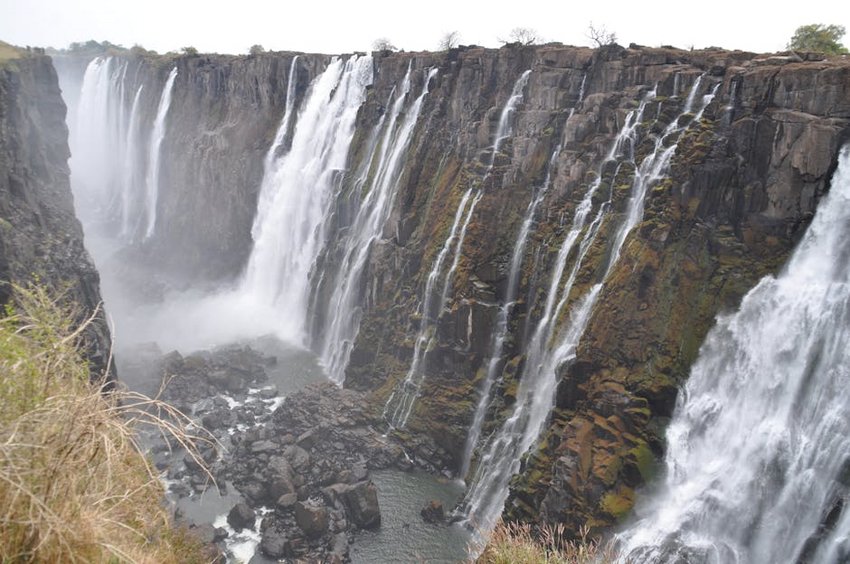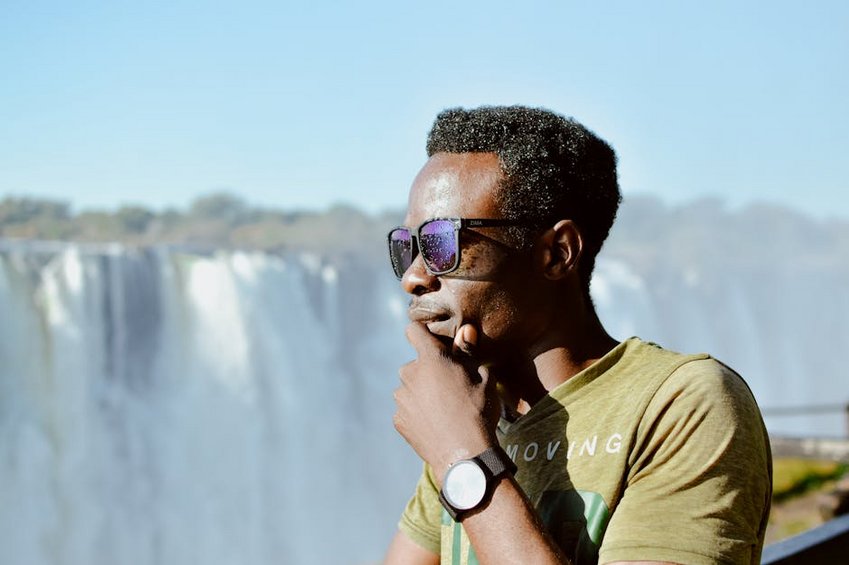Zambia Victoria Falls Devil’s Pool: Swimming on the Edge
The Zambia Victoria Falls Devil’s Pool offers a unique adventure where you can swim right at the edge of one of the world’s largest waterfalls during the dry season. This natural rock pool sits on the very brink of Victoria Falls, providing breathtaking views straight down into the gorge below. Your experience combines thrilling proximity to the falls with the safety of guided tours operating from August to December when water levels permit access.
Essential Victoria Falls Information
Victoria Falls, known locally as Mosi-oa-Tunya or “The Smoke That Thunders,” spans the border between Zambia and Zimbabwe in southern Africa. The waterfall measures 1,708 meters wide and drops between 90-107 meters into the Zambezi River gorge below. European explorer David Livingstone first documented the falls in 1855, though local tribes had cherished the site for centuries before his arrival.
The geological formation resulted from volcanic activity millions of years ago, with the Zambezi River carving through basalt plateau over time. Water volume varies dramatically throughout the year, ranging from 300 to 10,000 cubic meters per second between dry and wet seasons. This fluctuation directly impacts which activities remain accessible to visitors during different months.
What Makes Devil’s Pool Unique
Several factors distinguish this natural infinity pool from other waterfall experiences worldwide.
- The rock lip creates a natural barrier preventing swimmers from going over the edge during low water conditions from August to December.
- Livingstone Island serves as the access point, requiring a boat transfer and short swim to reach the pool itself.
- Guides accompany all visitors, providing safety instructions and capturing photographs of your once-in-a-lifetime moment at the precipice.
- Budget travelers spend $80-100 daily by staying in hostels, using public transport, and booking basic Devil’s Pool tours without extras while enjoying free viewpoints.
- Mid-range visitors allocate $150-250 per day for comfortable lodges, combination activity packages, restaurant meals, and transfers between attractions in Livingstone.
- Luxury experiences cost $300-500+ daily featuring premium safari lodges, private guides, helicopter flights over the falls, and exclusive dining experiences with waterfall views.
- Zambia Tourism Authority
- Lonely Planet Victoria Falls Guide
Seasonal Access and Water Conditions
Water levels determine when Devil’s Pool becomes accessible each year. The Zambezi River typically drops enough by mid-August to allow safe entry, with conditions remaining favorable through early December. Meanwhile, from January to July, high water volumes make the experience too dangerous, with tours redirecting to other activities.
During peak dry season in October and November, water flow might reduce to just 10-20% of maximum capacity. This creates the calmest swimming conditions but also means less dramatic waterfall views. Conversely, shoulder months like August and December offer stronger water flows while maintaining accessibility.
Geological Formation and Safety
The natural rock barrier forming Devil’s Pool resulted from specific volcanic basalt formations millions of years ago. This geological accident created a lip that rises slightly above water level during dry months, preventing currents from pulling swimmers over the edge. Meanwhile, the pool itself measures approximately 4 meters across with depths varying from 1-3 meters depending on recent rainfall.
Safety remains paramount, with all operators requiring visitors to follow guide instructions precisely. The rock surface can become slippery, so appropriate water shoes provide better traction. Additionally, all participants must demonstrate basic swimming ability before entering the water near the falls.

Alt: “victoria-falls-devils-pool-zambezi-river-dry-season”
Zambia Victoria Falls Devil’s Pool – Planning Your Trip
Planning your Zambia Victoria Falls Devil’s Pool adventure requires careful timing and preparation for optimal conditions. You should book tours several months in advance, particularly for September and October when demand peaks and availability becomes limited. Meanwhile, consider combining your Devil’s Pool experience with other Victoria Falls activities like helicopter flights or rhino walks in Mosi-oa-Tunya National Park.
Budget approximately $120-150 per person for the standard Devil’s Pool tour including boat transfer, guide, and refreshments. Premium packages costing $180-220 might include photography services, lunch on Livingstone Island, or combination tickets with other attractions. Remember that park entry fees add $20-30 per person, payable separately at the gate.
Physical preparation remains important, as accessing Devil’s Pool involves a short swim across calm water sections. While not strenuous, basic fitness and comfort in water ensure you fully enjoy the experience. Additionally, pack quick-dry clothing, waterproof camera protection, and secure footwear for the rocky terrain.
Best Time to Visit Devil’s Pool
Visit between late August and early December for optimal Devil’s Pool conditions with manageable water levels. September and October typically offer the best balance of accessibility and impressive waterfall flow. Temperatures range from 75-95°F (24-35°C) during these months with minimal rainfall.
Shoulder seasons in August and December provide good alternatives with slightly higher water volumes creating more dramatic mist. However, these months might experience occasional brief showers. Avoid planning your Devil’s Pool experience from January through July when high water levels make the activity unsafe and operators cancel tours.
Budget Planning and Costs
Consider these three budget tiers when planning your Victoria Falls adventure.
Essential Preparation Checklist
Pack quick-dry swimwear, secure water shoes, and waterproof cases for phones and cameras. Bring Zambian kwacha cash for park entry fees and tips, though major lodges and tour operators accept credit cards. Additionally, include sunscreen, hats, and light layers for changing conditions throughout the day.
Secure comprehensive travel insurance covering adventure activities and medical evacuation. Check visa requirements for your nationality, as many visitors obtain visas upon arrival for approximately $50. Furthermore, consult your doctor about malaria prophylaxis and ensure routine vaccinations remain current before traveling to Zambia.
Top Attractions and Activities
Beyond Devil’s Pool, Victoria Falls offers numerous unforgettable experiences across both Zambian and Zimbabwean sides. The Rainforest Walk on the Zambian side provides stunning frontal views of the eastern cataract, with mist often drenching visitors along the path. Meanwhile, the Knife-Edge Bridge offers spectacular vantage points looking across the main falls into the boiling pot below.
Adventure seekers find plenty of options, including white-water rafting on the Zambezi below the falls with rapids reaching Class V intensity. Bungee jumping from the Victoria Falls Bridge connects Zambia and Zimbabwe, sending participants 111 meters toward the river. Additionally, microlight and helicopter flights provide aerial perspectives of the entire waterfall system.
Must-See Highlights
The Zambian side’s Main Falls viewpoint delivers the closest accessible look at the precipice where water cascades into the first gorge. Visit during morning hours for better photography conditions with the sun behind you. Entry costs $20 per person with tickets valid for same-day reentry.
Livingstone Island remains historically significant as David Livingstone’s first viewpoint of the falls in 1855. Tours to the island typically include Devil’s Pool access during season. Meanwhile, the Boiling Pot hike descends into the gorge below the falls, offering unique upward perspectives of the cascade.
Sunset cruises on the upper Zambezi provide relaxing wildlife viewing with hippos, crocodiles, and numerous bird species. These two-hour excursions cost $45-60 per person including drinks and snacks. Additionally, cultural village tours offer insights into local Tonga traditions and crafts.
Hidden Gems and Local Favorites
Maramba Market in Livingstone offers authentic local shopping experiences away from tourist crowds. Here you’ll find traditional crafts, fresh produce, and everyday items at local prices. Meanwhile, the Railway Museum showcases colonial-era locomotives and the history of the Cape to Cairo railway project.
Simonga Village provides cultural immersion opportunities with guided visits to local homes, schools, and traditional healers. The nearby Songwe Village features ancient rock paintings and hiking trails with panoramic views of the Zambezi Valley. Additionally, less-visited sections of Mosi-oa-Tunya National Park offer rhino tracking without the crowds of more famous reserves.
Adventure Activities Beyond the Pool
White-water rafting seasons run from August to December, coinciding with Devil’s Pool accessibility. Full-day trips cover approximately 25 kilometers of rapids with professional guides and safety kayakers. Meanwhile, seasonal river boarding allows participants to navigate rapids using specially designed boards.
The Flying Fox zip-line sends riders soaring 200 meters across the gorge with spectacular waterfall views. For something tamer, canoe safaris on the upper Zambezi provide peaceful wildlife viewing opportunities. Additionally, fishing trips target tigerfish and other species in the river’s calmer sections above the falls.
Practical Travel Information
Livingstone serves as the primary gateway to Zambian Victoria Falls, offering accommodation ranging from backpacker hostels to luxury lodges. The town features restaurants, shops, and tour operators catering to various budgets and preferences. Meanwhile, Victoria Falls Town on the Zimbabwean side provides additional options just across the border.
Most visitors fly into Harry Mwanga Nkumbula International Airport (LVI) in Livingstone, with connections from Johannesburg, Nairobi, or Addis Ababa. Alternatively, you can enter via Victoria Falls Airport (VFA) in Zimbabwe and cross the border. Additionally, long-distance buses connect Livingstone with Lusaka and other Zambian cities for budget-conscious travelers.
| Accommodation Type | Features and Location | Price Range (USD) |
|---|---|---|
| Budget Hostels | Dormitory rooms, shared facilities, central Livingstone location, tour booking services | $15-30 per night |
| Mid-Range Lodges | Private rooms with en-suite bathrooms, swimming pools, restaurant and bar on site | $80-150 per night |
| Luxury Hotels | Riverfront locations, spa facilities, fine dining, private transfers included | $250-500+ per night |
| Safari Camps | All-inclusive packages, game drives, Zambezi River access, guided activities | $300-700 per night |


